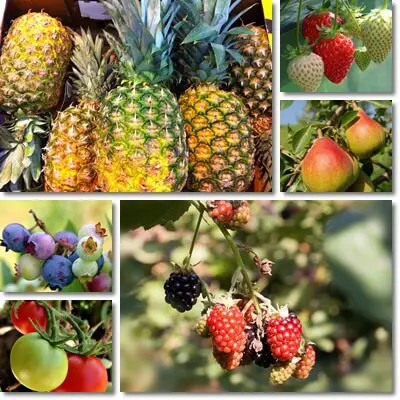It’s common knowledge that fruits have to be ripe before you eat them so you get the most nutrients out of them. But lately this piece of knowledge has been challenged by people who advocate for eating unripe fruits, saying they hold unknown benefits. Like for example, eating unripe bananas which are supposedly better for your figure. But nature always knows best and if a fruit is meant to ripen, then it’s also usually meant to be eaten when fully ripe in order to provide a maximum concentration of essential nutrients, antioxidants and the most health benefits.
Fruit appearance is an important indicator of nutritional value and is influenced primarily by ripeness. The riper the fruit, the more colorful it becomes, taking on beautiful, inviting red, orange, golden, pink or purple colors. And these colors are a strong indicator of strong antioxidants in edible fruits. Also, the riper the fruit, the more tender it is, meaning the easier it will be for it to be digested, with a maximum absorption of the nutrients it contains.

Believe it or not, even the smallest differences in ripeness can shift the nutritional value of fruits considerably. For example, a sour, green apple will have slightly more vitamin C than a ripe apple, but its fiber will be more resistant to digestive enzymes and you might absorb less nutrients overall because a part of them will bind to the indigestible fiber and be taken out of the body. Also, unripe apples will not have developed their antioxidant potential to the fullest: while the green apple peel might contain chlorophyll, the ripe apple peel will contain anthocyanins and other antioxidants such as quercetin, chlorogenic acid and catechins and provide better antioxidant protection overall.
On average, nutrients in a ripe fruit reach a peak and become somewhat easier to digest and absorb, meaning they are overall more likely to bring more benefits. Of course, exceptions exist. So what is the difference between ripe and unripe fruit and which is healthier for you? Here are the top 6 differences and what they mean for you health:
1) Ripe fruits have more antioxidants
In most cases, the peel and sometimes the flesh change color as a fruit ripens and this change in color indicates a change in antioxidant profile as well. Most unripe fruits are green and their pigment is a result of the presence of chlorophyll, also an antioxidant with beneficial effects. But ripe fruits can be yellow, orange, pink, red or purple and contain far greater amounts of different color-giving antioxidants that develop as a result of the ripening process, boosting the overall antioxidant value of the fruit. And then there are antioxidants such as quercetin, chlorogenic acid, catechins, epicatechins and other polyphenolic compounds which increase in amount the longer fruits are exposed to sunlight and the more they are allowed to ripen.
Examples of color-giving antioxidants in fruit:
– many red, blue and purple fruit contain anthocyanins (apples, peaches, cherries, pears, plums, cherry plums, blueberries, red and purple raspberries etc.)
– orange fruit contain carotenoids such as beta-carotene (mango, papaya, pumpkin, cantaloupe, Karat bananas, apricots), alpha-carotene (pumpkin), lutein and zeaxanthin (avocado, kiwifruit).
– red fruit have antioxidants such as lycopene (watermelon, tomatoes, pink grapefruit, gac fruit).

2) Ripe fruits have more vitamins
The main reason ripe fruits are generally healthier than unripe ones is because they have more vitamins. For example, yellow-orange fruits like cantaloupe, mango, papaya, apricots are rich in beta-carotene when ripe and beta-carotene is a precursor for vitamin A. Beta-carotene is converted into vitamin A and goes on to provide benefits for eyesight, skin health and immune system.
Unripe strawberries are bland tasting, but ripe strawberries are sour because they develop a great content of vitamin C to boost immunity and reduce inflammation. And most fruits in general need to ripen completely to reach a maximum level of vitamins and provide the benefits we know they do.
3) Unripe, sour fruits may have more vitamin C
This is probably the main exception to the rule. While strawberries and other fruits that are bland-tasting when unripe develop vitamin C when ripe, fruits that are sour when unripe generally have more vitamin C then than when they ripen. Cherry plums for example start out extremely sour and rich in vitamin C, but sweeten considerably as they ripen and lose a great deal of the nutrient.
4) Ripe fruits have more minerals
Research shows the longer a fruit is left on the tree or bush to ripen, receiving sunlight and water and nutrients from the soil, the more minerals it accumulates. This is because dietary minerals are drawn by plants into their fruits from the ground and need time to accumulate. Of course, soil quality, use of natural fertilizers to improve soil quality and other factors will influence the end mineral content of fruits.
5) Unripe fruits are harder to digest
This here is the reason why unripe bananas are said to have less calories and help you lose weight. Dietary fiber is essentially indigestible plant material that remains unchanged by digestive enzymes. It is found everywhere in plant food sources and serves certain purposes (read more about the benefits of fiber). But the fiber in unripe fruits is particularly rough which makes the fruits harder to chew and harder to digest, hence the reason why eating an unripe banana, papaya or cherry plums often cause stomach upset.
Unripe fruits further contain complex carbohydrates like starches that are resistant to digestion, similar to fiber, adding to the lack of digestibility. In ripe fruits, these resistant starches turn into natural sugars that give the fruits their sweet taste and turn their pulp soft and mellow. In other words, the ripening process causes complex carbohydrates that are difficult to digest to break down into simpler forms, basically sugars, that are digested almost instantly. And so ripe fruits will have less indigestible plant material and be easier on the stomach.
6) Unripe fruits have less sugar and calories
The reason why ripe fruits have more sugar and calories is because some of the complex carbohydrates they contained have turned into sugars naturally as a result of the ripening process. So while they are easier to chew and digest, without causing stomach upset, abdominal cramps or bloating, they have more sugars and, implicitly, calories (read more about why eating unripe, green fruits is bad for you).
Conclusion
Nutrition experts recommend eating ripe fruits rather than unripe ones. In addition to being easy on the stomach as a result of a better fiber profile, they provide excellent nutrition and are important sources of antioxidants with multiple health benefits. If you want to lose weight, simply choose fruits with a naturally low sugar content, low in calories and with a high water content. Watermelon, apricots and apples are good choices. Also, some of the healthiest fruits are those with edible peel or skin, an important source of antioxidants as a result of a direct contact with sunlight.
